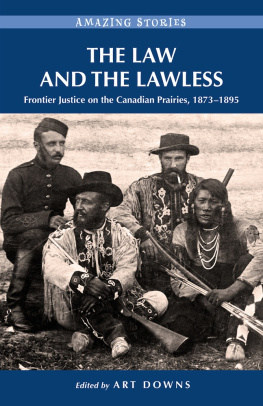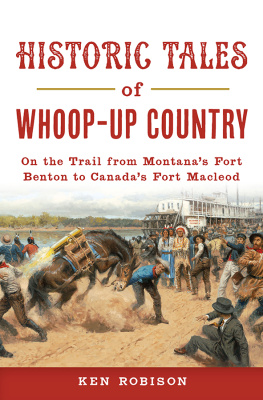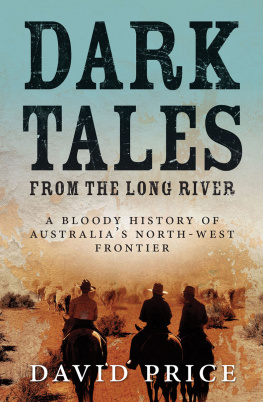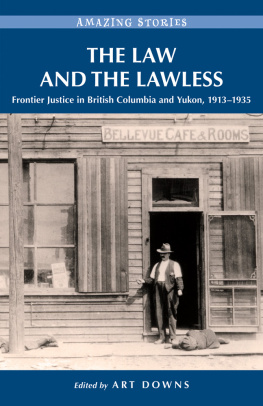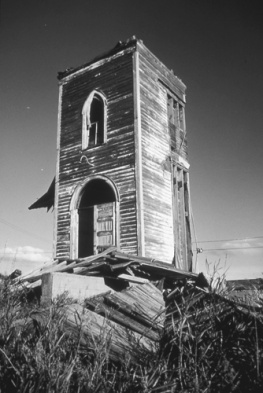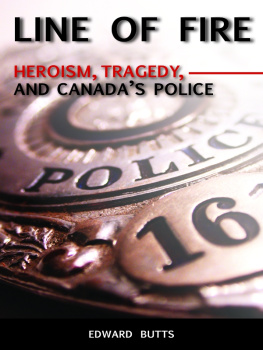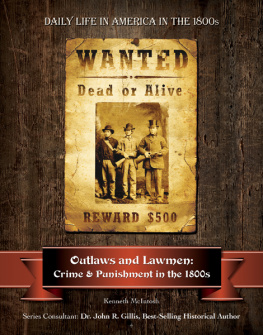CHAPTER
The March
of the Mounties
The Lawless Land
In 1869, the fledgling Dominion of Canada agreed to give the Hudsons Bay Company (HBC) some $1.5 million and land grants to relinquish its rights to Ruperts Land and its trading monopoly in what was then called the North-Western Territory. In return, the Dominion gained control of a region that would later include most of Quebec and Ontario and all of Manitoba, Saskatchewan, Alberta, Yukon, Northwest Territories, and Nunavut. A lieutenant-governor and council were appointed as administrators, and Prime Minister John A. Macdonald decided to form a mounted police force to maintain order. Unfortunately, this latter plan was dropped, and a region rivalling the US in size became a land of no law.
For some two hundred years, the HBC had administered what law there was in the West. Under its jurisdiction, chief factors were given powers to try criminal cases and endeavoured to preserve law and order for the benefit of profit and loss. Nevertheless, between 1778, when the white man first began to penetrate the plains on a regular and organized basis, and 1874, when the North West Mounted Police (NWMP) arrived, the question of crime and punishment was largely academic. Company posts were isolated, the white population small, and Native people administered their own justice.
With the transfer of the region from HBC control, a new element was introduced into the Native way of lifeunlimited liquor. The HBC and other traders certainly were not teetotallers in their transactions with Native people, but they did exercise control on the sensible premise that drunken individuals made poor trappers and could be unpredictable and dangerous, let alone bad for business. Hence they strove to have the Native way of life disturbed as little as possible and even actively discouraged any settlement of their vast domain.
In the late 1860s, however, a dramatic change occurred. The American Civil War was now history, and covered wagons by the thousands rumbled across the plains carrying settlers to California, Oregon, and other western regions. Among the new communities to appear was Fort Benton on the Upper Missouri River, about 160 kilometres south of what would one day be Alberta.
Fort Benton became the supply area for a massive region of the US plains and for unprincipled free traders who ventured north to challenge the HBC trading monopoly. Their main stock-in-trade was whisky. Without concern for its catastrophic consequences, they dispensed it from trading posts, or forts, as they called them, with colourful names such as Whiskey Gap, Robbers Roost, Fort Slide Out, Fort Stand Off, Spitzee Post, and Fort Whoop-Up. The latter, on the outskirts of modern-day Lethbridge and now a national historic site, became the focal point of the liquor traffic.
In 1869, John J. Healy and Alfred B. Hamilton, two US traders from Fort Benton, built eleven log cabins at the junction of the St. Mary and Oldman Rivers. They surrounded the cabins with a flimsy palisade and that winter netted $50,000. This post, called Fort Hamilton, burned down in 1871, but by that time work was well underway on a new fort a short distance awayone that wouldnt burn so easilywhich became known as Fort Whoop-Up. It was built of heavy, squared timbers with a sturdy palisade loopholed for rifles and two bastions complete with cannon. On one of the bastions was a flagpole from which fluttered Healys personal blue and red flag, which at a distance resembled the Stars and Stripes.
Native traders were seldom permitted inside the palisade. They pushed their buffalo hides and other items through a small wicket near the main gate and exchanged them for blankets, guns, and whiskyparticularly whisky. Then, crazed by the firewater and thirsting for more, they often traded not only the horses they needed to hunt but also their wives and daughters.
Each trader brewed his own brutal concoction. A typical recipe diluted one gallon of raw alcohol with three gallons of water, to which was added a pound of tea, a handful of red peppers, some Jamaica ginger, a pound of chewing tobacco, some Castille soap, Perrys Painkiller, or even a dash of lye to give it bite since the Blackfoot liked whisky that burned on the way down. The brew was brought to a boil to blend the ingredients, then ladled out in tin cups. I never knowed what made an Injun so crazy when he drank till I tried this booze, wrote cowboy author-artist Charles M. Russell. You could even shoot a man through the brain or heart and he wouldnt die till he sobered up.
Probably the most damning indictment against the whisky traders was written by the Reverend John McDougall, one of the Wests renowned missionaries. He noted:
Scores of thousands of buffalo robes and hundreds of thousands of wolf and fox skins and most of the best horses the Indians had were taken south into Montana, and the chief article of barter for these was alcohol. In this traffic, very many Indians were killed, and also quite a number of white men. Within a few miles of us... forty-two able-bodied men were the victims among themselves, all slain in the drunken rows. These were Blackfoot... There was no law but might. Some terrible scenes occurred when whole camps went on the spree, as was frequently the case, shooting, stabbing, killing, freezing, dying.
Missionaries and others, including the US government, the HBC, and the Canadian Pacific Railway (CPR), urged the Dominion to form a mounted force to police the West. The Dominion government responded in 1872 by sending Colonel Robertson-Ross, adjutant general for the Canadian militia, to the West for an official opinion. On his return, he promptly recommended that a mounted police force of 550 riflemen be established.
As a consequence, in May 1873, Parliament passed a bill providing for the establishment of a Police Force in the North-West Territories, and for magistrates, courts, and jails. But Prime Minister Sir John A. Macdonald put off implementing the legislation. He didnt oppose the forcein fact he had been the primary motivator behind the legislationbut Macdonald was a marvelous procrastinator, so accomplished that he earned the nickname Old Tomorrow.
Fortunately, Alexander Morris was among those who recognized the desperate need for a western police force. Morris had been a member of Macdonalds cabinet but resigned in 1872 to become lieutenant-governor of the province of Manitoba and the vast North-West Territories. He continued to press for a police force, cautioning Macdonald that a most important matter... is the preservation of order in the Northwest and little as Canada may like it she has to stable her elephant.

Map of Canada, 187071.
But even though the legislation to establish the police force had passed unanimously, Macdonald was in no hurry to stable the elephant and didnt intend to begin recruiting until the next year. Though he didnt know it yet, there had already been a massacre in the West that was to change his leisurely schedule.
The March of the Mounties
The Cypress Hills straddle the southern border of todays provinces of Alberta and Saskatchewan. For centuries, the area has been a favourite refuge for Native people. Its abundant Jack pine made excellent teepee poles, and it was rich in buffalo, black and grizzly bear, deer, and other wildlife. The white men found the Cypress Hills equally attractive, especially the whisky traders. Among them were Abel Farwell and Moses Solomon, who built whisky forts nearly side by side, deep in the hills. In May 1873, a band of Assiniboine were camped near Farwells post and, as later reported, whiskey flowed like water... and by mid-day the tribesmen were all hopelessly drunk.

